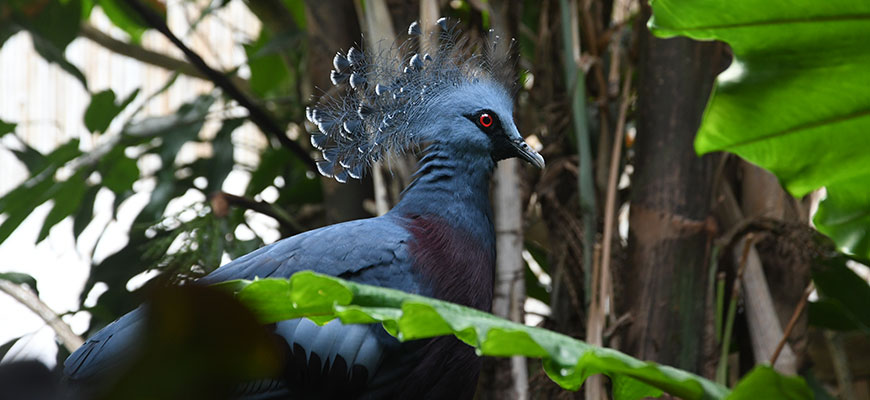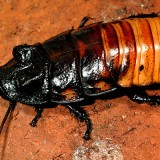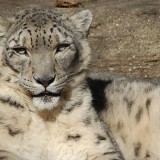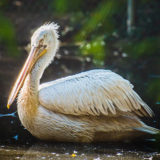CLASSIFICATION
Order: Columbiformes
Family: Columbidae
Genus: Goura
Species: victoria
Order: Columbiformes
Family: Columbidae
Genus: Goura
Species: victoria
RANGE
New Guinea and a few adjoining islands.
HABITAT
Moist lowland rain forests, generally up to about 110 m in elevation.
SIZE
Victoria’s crowned pigeons are 24 – 28 inches long. They weigh about 4 ½ pounds.
LIFE EXPECTANCY
Wild: Unknown
Captivity: 15 – 20 years
Captivity: 15 – 20 years
REPRODUCTION
During courtship, the male gives a loud booming call. Other displays include a bow, in which the male spreads and erects his tail, partly opens his wings, and bows his head. In addition he may also dance on the ground with wings up-stretched while the female lifts her wings high and runs around him in a circle. Once the male chooses the nesting site he will initially present nesting material to the female, later either may present.
Nests are solid, compact, and built of dead stems, sticks, and leaves. They are low to the ground, usually about 12–50 feet from ground level. They prefer areas with tall hedges and thickets to woodlands. The female lays one or two white elliptical eggs; they may have a bluish tint to them. Incubation lasts from 28–30 days; both the male and female share the responsibility. Shortly before the chick is due to hatch, the lining of the parent birds’ crop begins to thicken. This lining sloughs off to form a cheesy material commonly called “crop milk”. The parents regurgitate this to feed the chick until it is 3 – 10 days old. As the chick grows, grain and fruit are added to the diet. The newborn chicks are “altricial,” meaning they are almost helpless after hatching and require attentive parental care and feeding. The young birds can fly when they are three weeks old and will leave the nest around one month in age. Parents will continue to feed the chicks for a short period after fledging. Captive birds reach sexual maturity in their second year.
Nests are solid, compact, and built of dead stems, sticks, and leaves. They are low to the ground, usually about 12–50 feet from ground level. They prefer areas with tall hedges and thickets to woodlands. The female lays one or two white elliptical eggs; they may have a bluish tint to them. Incubation lasts from 28–30 days; both the male and female share the responsibility. Shortly before the chick is due to hatch, the lining of the parent birds’ crop begins to thicken. This lining sloughs off to form a cheesy material commonly called “crop milk”. The parents regurgitate this to feed the chick until it is 3 – 10 days old. As the chick grows, grain and fruit are added to the diet. The newborn chicks are “altricial,” meaning they are almost helpless after hatching and require attentive parental care and feeding. The young birds can fly when they are three weeks old and will leave the nest around one month in age. Parents will continue to feed the chicks for a short period after fledging. Captive birds reach sexual maturity in their second year.
DIET
In the wild they are believed to feed on fallen fruits, seeds, berries, insects, and other invertebrates. In zoos they are fed papaya, avian maintenance pellets, mealworms, corn grubs, and Bird of Paradise pellets.
BEHAVIOR
All pigeon and dove species move about in flocks during the day and roost together at night. These birds begin their morning with a chorus of calls before the flock sets out to feed and drink. They forage for food on the ground, perching on the low branches of trees only when disturbed or to roost. They then return to their perching place, where they stay during the hottest part of the day. In the afternoon they again go off to feed and drink, finally retiring at night.
POINTS OF INTEREST
The three crowned pigeon species are similar in coloration and size. All are blue-gray with patches of maroon. They have long tails, red eyes, stout red legs, and large, lacy, fan-like head crests, for which they have been widely hunted. In addition to being hunted for their crests, these pigeons are also hunted for their flesh, which, like that of all pigeons is good eating. The largest of the pigeons, these birds have almost disappeared from near human habitations, but are reported to be fairly common in the wilder jungles of New Guinea.
STATUS
The Victoria crowned pigeon is listed as vulnerable by IUCN. The common-crowned pigeon is listed on Appendix II of the Convention on International Trade in Endangered Species of Wild Flora and Fauna (CITES). Despite this legal protection they remain under heavy pressure from illegal hunting and the demands of the Southeast Asian pet trade.
BIBLIOGRAPHY





